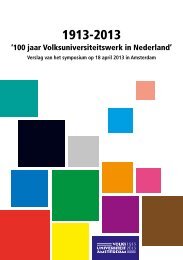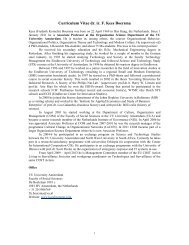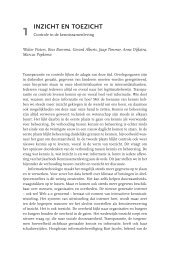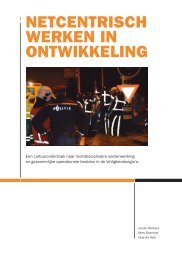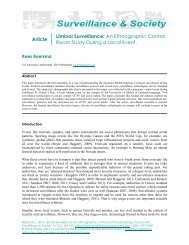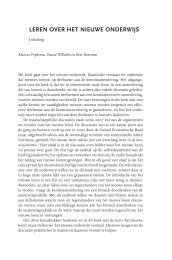Access article in PDF - Project MUSE - Johns Hopkins University
Access article in PDF - Project MUSE - Johns Hopkins University
Access article in PDF - Project MUSE - Johns Hopkins University
You also want an ePaper? Increase the reach of your titles
YUMPU automatically turns print PDFs into web optimized ePapers that Google loves.
68 BOERSMA<br />
terests, and relations can result <strong>in</strong> the emergence of subcultures<br />
with<strong>in</strong> the research organization. This view is consistent with Joanne<br />
Mart<strong>in</strong>’s theoretical <strong>in</strong>vestigations of organizational cultures <strong>in</strong> a<br />
broader sense. She argues that, because of cognitive and normative<br />
diversity with<strong>in</strong> an organization, the attribution of mean<strong>in</strong>g (an important<br />
part of the cultural process) is complicated and leads to fragmentation<br />
as well as <strong>in</strong>tegration, diversity as well as unity. 10 The<br />
most difficult task for a research director, then, is to create organizational<br />
unity with regard to major company goals while giv<strong>in</strong>g <strong>in</strong>dividual<br />
researchers a feel<strong>in</strong>g of freedom <strong>in</strong> their scientific work.<br />
A second problem <strong>in</strong> the analysis of the <strong>in</strong>dustrial research laboratory<br />
is the relationship between the evolution of a laboratory culture<br />
and a company’s choices concern<strong>in</strong>g technological <strong>in</strong>novation.<br />
Decisions about whether or not to <strong>in</strong>vest <strong>in</strong> specific long-term projects<br />
are made at both the top management and the local research<br />
levels and are part of an evolv<strong>in</strong>g bus<strong>in</strong>ess strategy that shapes technological<br />
<strong>in</strong>novation. Both the research director and the company<br />
managers have to f<strong>in</strong>d a balance between the company’s strategy and<br />
the priorities and skills of the research staff, who develop their particular<br />
bodies of knowledge not only <strong>in</strong> response to personal and<br />
company needs but also <strong>in</strong> relation to professional networks that<br />
transcend the laboratory’s boundaries. The laboratory leader must<br />
f<strong>in</strong>d a balance between an open research culture attuned to the overall<br />
scientific concerns of the day and the specific product <strong>in</strong>terests<br />
of the company.<br />
In this <strong>article</strong>, I focus on the development of the X-ray department<br />
at the Philips Physics Laboratory and particularly on the role of <strong>in</strong>dividuals<br />
operat<strong>in</strong>g <strong>in</strong> an <strong>in</strong>dustrial research culture. Radiography<br />
research was conducted under the leadership of Gilles Holst (the<br />
Physics Laboratory’s research director) and Albert Bouwers (the<br />
X-ray department’s group leader). As this <strong>in</strong>vestigation will show,<br />
the success of these <strong>in</strong>dividuals <strong>in</strong> their scientific and technological<br />
fields did not automatically lead to profitable products for the company;<br />
the expectation that technological <strong>in</strong>novation will produce future<br />
success is not always fulfilled. 11 Moreover, failure <strong>in</strong> <strong>in</strong>novation<br />
has consequences for the cultural unity of a research organization.<br />
The questions addressed here <strong>in</strong>clude the follow<strong>in</strong>g: How did Holst<br />
first become <strong>in</strong>terested <strong>in</strong> the subject of radiographic technology, and<br />
what was the relationship between the X-ray research effort and the<br />
10. Joanne Mart<strong>in</strong>, Cultures <strong>in</strong> Organizations: Three Perspectives (New York,<br />
1992).<br />
11. For this theme see Harro van Lente, Promis<strong>in</strong>g Technology: The Dynamics<br />
of Expectations <strong>in</strong> Technological Developments (Delft, 1993).



